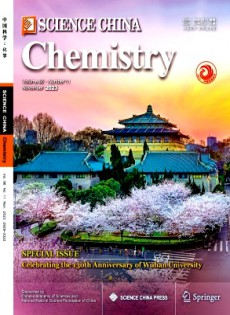《Science China Chemistry》的版面费计算方法如下:
1.按版面计算:具体版面计算方式可联系杂志社或咨询在线客服。如果文章超出定义范围则需要多支付一版面的费用。
2.按字数计算:有些期刊会根据论文的字数来计算版面费,例如每千字收取一定费用。
3.额外费用:如果文章需要彩色印刷(如图表、图片),可能会额外收取费用。
4.期刊级别和收录数据库:期刊的级别和被不同数据库收录的情况也会影响版面费。例如,知网收录的期刊版面费通常较高。
5.期刊政策与优惠:部分期刊可能对特定群体(如学生、学者等)提供版面费优惠。
6.开放获取:开放获取期刊通常按文章收取费用,费用较高,涵盖同行评审、编辑、出版和在线传播等成本。
《Science China Chemistry》杂志的版面费计算方式相对明确,主要依据文章所占据的版面数量进行收费。作者在投稿前,应仔细核对文章字数,并根据期刊的收费标准合理预算版面费。
《Science China Chemistry》杂志创刊于1950年,是一本由中国科学院主管、主办的学术性期刊。该杂志为月刊,审稿周期为预计1-3个月,国内统一刊号为11-5838/O6,国际标准刊号为1674-7224。
《Science China Chemistry》杂志的主要栏目包括: 快报、评述、论文,该杂志注重学术性与实践性结合,鼓励创新性研究,尤其欢迎具有理论深度或实证价值的论文。其刊载文章多涉及科技政策分析、科技技术应用等热点议题,为科技工作者提供前沿的学术参考。
该杂志在学术界具有较高影响力,被EI 工程索引(美)、知网收录(中)、JST 日本科学技术振兴机构数据库(日)、CSCD 中国科学引文数据库来源期刊(含扩展版)、上海图书馆馆藏、万方收录(中)、CA 化学文摘(美)、维普收录(中)、SCI 科学引文索引(美)、国家图书馆馆藏收录,这意味着论文能够被更广泛的学术群体检索和引用,有助于提升研究成果的传播范围和学术影响力。
根据最新数据,其影响因子:1.02,表明该杂志在科技研究领域具有较高的学术认可度。
《Science China Chemistry》杂志须知(审稿周期:预计1-3个月)
Manuscript submission
Please provide in a cover letter the background, innovative and scientific value of the work presented in the manuscript, and authors’ publications related to this work. The detailed contact information of the first author and corresponding author is re-quired. (Please promptly inform the editorial office of any change of contacting emails and addresses.) The authors may
recommend 3–8 qualified reviewers and/or request the exclusion of specific reviewers. An informative cover letter is considered helpful for editors and reviewers to make evaluation of the sub-mitted manuscript.
Duplicate submission is forbidden and unethical. In such cases, the journal will inform the institution of the authors and the relevant journal(s).
Poor English expression of a submitted manuscript may lead to rejection.
Ethical responsibilities of authors
This journal is committed to upholding the integrity of science and the scientific record. As a member of the Committee on Publica-tion Ethics (COPE), the journal will follow the COPE guidelines on how to deal with potential acts of misconduct.
Authors should refrain from misrepresenting research results which could damage the trust in the journal and ultimately the entire scientific endeavor. Maintaining integrity of the research and its presentation can be achieved by following the rules of good scientific practice, which includes:
1.The manuscript has not been submitted to more than one journal for simultaneous consideration.
2.The manuscript has not been published previously (part-ly or in full), unless the new work concerns an expansion of previous work. (Please provide transparency on the re-use of material to avoid the hint of text-recycling (“self-plagiarism”).)
3.A single study is not split up into several parts to in-crease the quantity of submissions and submitted to var-ious journals or to one journal over time (e.g., “sala-mi-publishing”).
4.No data have been fabricated or manipulated (including images) to support the conclusions. Upon request au-thors should be prepared to submit relevant documenta-tion or data in order to verify the validity of the results. This could be in the form of, e.g., raw data, samples, and records.
5.No data, text, or theories by others are presented as if they were the authors’ own (“plagiarism”). Proper acknowledgements to other works must be given, in-cluding material that is closely copied (near verbatim), summarized and/or paraphrased. Quotation marks are used for verbatim copying of material, and permissions need to be secured for material that is copyrighted.
Important note: The journal may use software to screen for plagiarism.
6.Consent to submit, including each version of the paper and any change in authorship, has been received from all co-authors and responsible authorities at the institute/ organization where the work has been carried out before the work is submitted or re-submitted for publication. In addition, authorship changes or the order of authors are not accepted after acceptance of a manuscript. Requests to add or delete authors at the revision stage or after publication is a serious matter, and may be considered only after receipt of a written approval from all authors and detailed explanation about the role/deletion of the new/deleted author. The decision whether to accept the change rests with the Editor-in-Chief of the journal.
7.Authors whose names appear on the submission have contributed sufficiently to the scientific work and there-fore share collective responsibility and accountability for the results.
省级期刊
省级期刊
部级期刊
统计源期刊
统计源期刊
